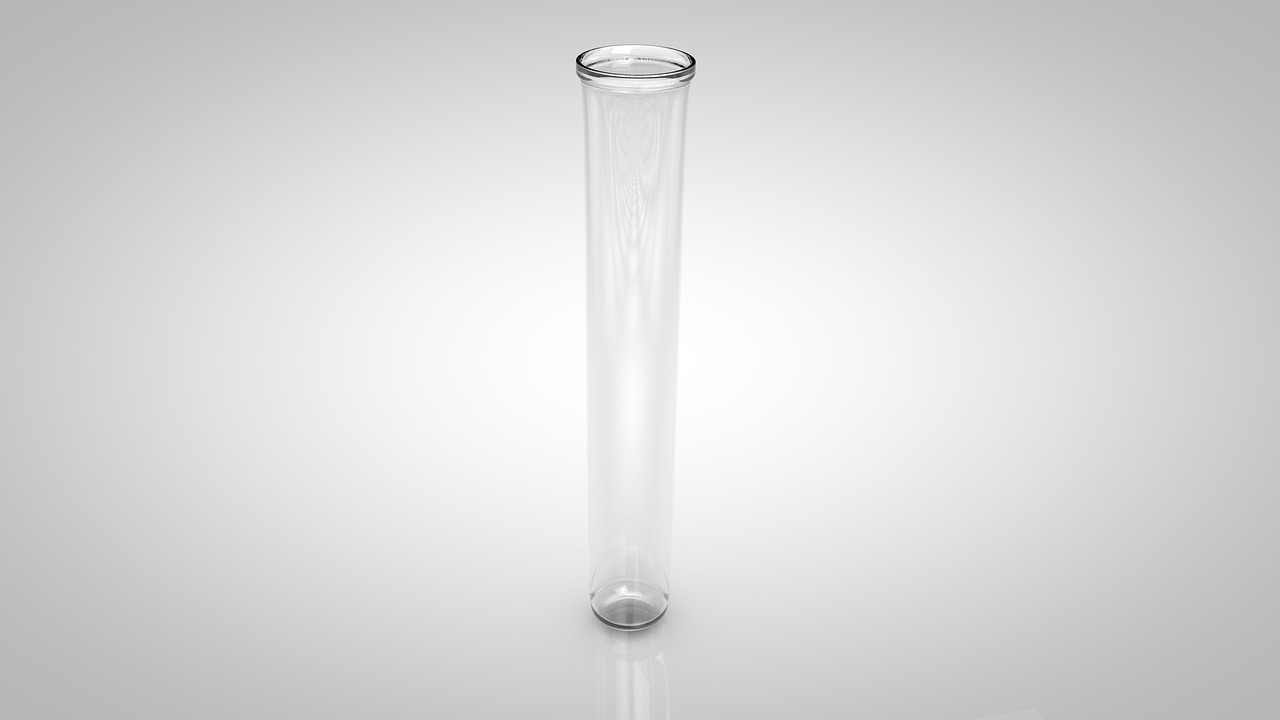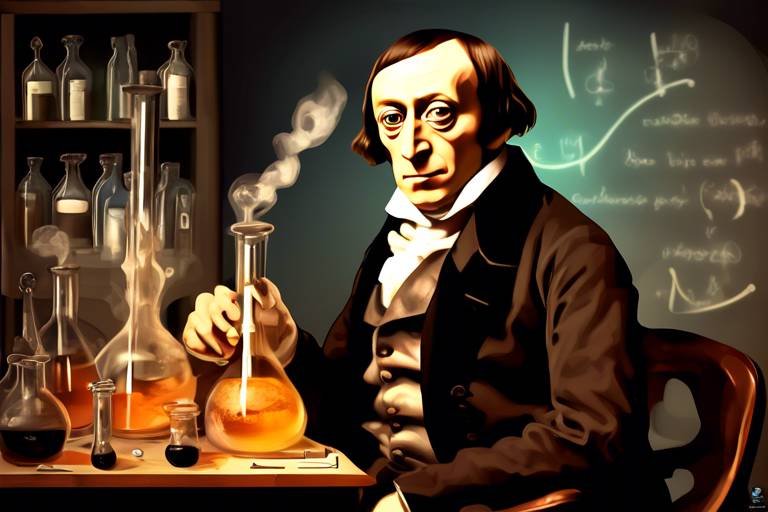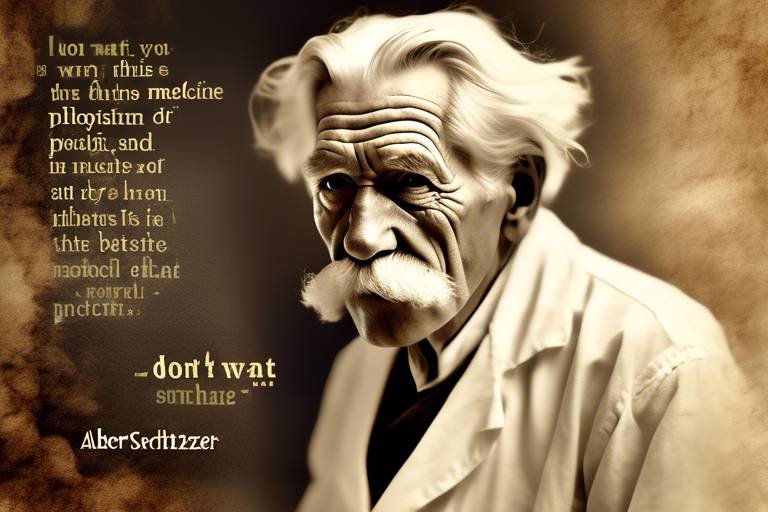The Discoveries of Amedeo Avogadro in Chemistry
Amedeo Avogadro, an Italian scientist born in 1776, is a name that resonates profoundly in the world of chemistry. His groundbreaking discoveries have not only shaped our understanding of gases but have also laid the foundational stones for molecular theory. Imagine a world where the behavior of gases was a mystery; Avogadro stepped in and illuminated this dark corner of science. His insights were not just theoretical musings but practical revelations that transformed the landscape of chemistry forever.
One of Avogadro's most significant contributions is his hypothesis regarding gases. He proposed that equal volumes of gases, at the same temperature and pressure, contain an equal number of molecules. This was a revolutionary idea at the time, challenging existing notions and paving the way for the gas laws we study today. Think of it as a key that unlocked the door to understanding how gases behave, interact, and can be manipulated in various chemical processes.
The implications of Avogadro's hypothesis were profound. It provided a clear and concise method for scientists to relate the macroscopic properties of gases to their molecular structure. This connection is crucial because it allows chemists to predict how different gases will react under various conditions. Without Avogadro's insights, our grasp of chemical reactions involving gases would be far less sophisticated.
Another monumental aspect of Avogadro's work is the concept of the mole. This term might sound simple, but it serves as a bridge between the atomic scale and the quantities we can measure in the laboratory. The mole allows chemists to count particles by weighing them, which is essential for stoichiometric calculations. To put it in perspective, think of the mole as a dozen eggs; just as a dozen signifies twelve eggs, a mole signifies approximately 6.022 x 10²³ particles of a substance. This uniformity in counting is what makes chemistry calculations manageable and precise.
Avogadro's law further elaborates on his findings, stating that the volume of a gas is directly proportional to the number of moles of that gas at constant temperature and pressure. This principle is crucial for understanding gas behavior in chemistry. It means that if you double the number of moles of a gas, you also double its volume, assuming temperature and pressure remain unchanged. This relationship is not just a theoretical concept; it has real-world applications in everything from industrial processes to environmental science.
The legacy of Avogadro's discoveries extends far beyond his lifetime. His work significantly advanced molecular theory by establishing a clear relationship between molecules and their volumes. This insight was a stepping stone for later developments in atomic theory and chemical bonding. Today, when we study molecular structures and reactions, we are standing on the shoulders of giants like Avogadro, whose foundational ideas continue to influence modern chemistry.
In practical applications, Avogadro's principles are essential in various fields, including analytical chemistry, biochemistry, and environmental science. For example, in analytical chemistry, understanding the mole concept allows scientists to accurately measure substances and predict the outcomes of chemical reactions. In biochemistry, it helps in understanding metabolic pathways and the behavior of gases in biological systems. The versatility of Avogadro's discoveries is a testament to their importance in scientific research and education.
Amedeo Avogadro's contributions have earned him a lasting legacy. Numerous honors and recognitions have been named in his memory, reflecting the profound impact of his work on the scientific community. His ideas continue to inspire new generations of scientists, ensuring that his legacy will endure for years to come.
- What is Avogadro's hypothesis?
Avogadro's hypothesis states that equal volumes of gases, at the same temperature and pressure, contain an equal number of molecules. - What is a mole in chemistry?
The mole is a unit that measures the amount of substance, allowing chemists to count particles by weighing them. One mole is approximately 6.022 x 10²³ particles. - How does Avogadro's law work?
Avogadro's law states that the volume of a gas is directly proportional to the number of moles of that gas at constant temperature and pressure. - Why is Avogadro's work important?
His work laid the foundation for modern chemistry, particularly in understanding gas behavior and molecular theory.

Avogadro's Hypothesis
Avogadro's hypothesis is one of those brilliant flashes of insight that changed the way we understand the world around us, especially in the realm of chemistry. Imagine being able to look at two balloons filled with different gases, yet knowing that if they occupy the same volume at the same temperature and pressure, they must contain the same number of molecules. This is exactly what Avogadro proposed! His hypothesis states that equal volumes of gases, at the same temperature and pressure, contain an equal number of molecules. This groundbreaking idea is not just a mathematical curiosity; it laid the foundation for modern gas laws and molecular theory.
To grasp the significance of Avogadro's hypothesis, consider the implications it has on our understanding of gas behavior. Before Avogadro, the relationship between gas volume and the number of particles was largely a mystery. His hypothesis provided a clear and concise way to connect the macroscopic properties of gases with their microscopic structure. This connection is vital for chemists, as it allows them to predict how gases will behave under various conditions.
Let’s break down Avogadro's hypothesis a bit further. It can be summarized in a few key points:
- Volume and Molecules: If two gas samples have the same volume, temperature, and pressure, they will have the same number of molecules, regardless of the type of gas.
- Implications for Chemical Reactions: This principle allows chemists to calculate the amounts of reactants and products in a chemical reaction based on gas volumes.
- Foundation for Gas Laws: Avogadro's hypothesis is a cornerstone for deriving other gas laws, such as Boyle's Law and Charles's Law.
Avogadro's hypothesis was not widely accepted initially, primarily due to the lack of experimental evidence supporting it. However, as scientific techniques improved, his ideas gained traction. Today, we recognize Avogadro's hypothesis as a crucial milestone in chemistry. It serves as a bridge between the observable properties of gases and the invisible world of molecules, allowing us to understand and manipulate chemical reactions with greater precision.
In practical terms, Avogadro's hypothesis means that chemists can use simple measurements to make complex calculations. For instance, if a chemist knows the volume of a gas at a given temperature and pressure, they can determine the number of molecules present. This is incredibly useful in a laboratory setting, where accurate measurements are essential for successful experiments.
In summary, Avogadro's hypothesis is not just an abstract concept; it's a powerful tool that has transformed our understanding of gases and their behaviors. By establishing a clear relationship between volume and the number of molecules, Avogadro opened the door to a multitude of scientific advancements that continue to shape the field of chemistry today.

The Mole Concept
The mole concept is one of the cornerstones of chemistry, bridging the gap between the microscopic world of atoms and molecules and the macroscopic world we can see and measure. Introduced by Amedeo Avogadro, this concept allows chemists to quantify substances in a way that is both practical and insightful. Imagine trying to bake a cake without knowing how many cups of flour you need; similarly, in chemistry, without the mole, we would struggle to understand how to mix substances in the right proportions.
At its core, the mole is a unit that measures the amount of substance. One mole of any substance contains exactly 6.022 x 10²³ entities, be they atoms, molecules, ions, or other particles. This number, known as Avogadro's number, is not just a random figure; it's a fundamental constant that allows chemists to convert between the atomic scale and measurable quantities. For instance, if you have one mole of water, you know you have about 18 grams of it. This connection is crucial because it simplifies calculations in chemical reactions.
To illustrate the mole concept further, let's consider how it applies to different substances. Here’s a quick comparison:
| Substance | Molar Mass (g/mol) | Number of Molecules in 1 Mole |
|---|---|---|
| Water (H₂O) | 18 | 6.022 x 10²³ |
| Carbon Dioxide (CO₂) | 44 | 6.022 x 10²³ |
| Sodium Chloride (NaCl) | 58.5 | 6.022 x 10²³ |
This table highlights how different substances have different molar masses, but they all contain the same number of particles when measured by moles. This is what makes the mole concept so powerful—it provides a uniform way to discuss and calculate the quantities of various substances in chemical reactions.
Furthermore, the mole concept is not just about counting particles; it's also about understanding the relationships between them. For example, in a chemical reaction, knowing the number of moles of reactants allows chemists to predict how many moles of products will be formed. This predictive power is essential in both laboratory settings and industrial applications, where precise measurements can mean the difference between success and failure.
In summary, the mole concept is a revolutionary idea that has transformed the way we approach chemistry. It allows scientists to move seamlessly between the world of atoms and the practicalities of laboratory work. By providing a clear framework for understanding and measuring substances, the mole concept continues to be an invaluable tool for chemists around the globe.
- What is a mole in chemistry? A mole is a unit of measurement that represents 6.022 x 10²³ particles of a substance, allowing chemists to count and measure substances easily.
- Why is Avogadro's number important? Avogadro's number provides a bridge between the microscopic world of atoms and the macroscopic world we can measure, enabling precise calculations in chemical reactions.
- How do I calculate the number of moles in a substance? To calculate the number of moles, divide the mass of the substance (in grams) by its molar mass (in g/mol).

Avogadro's Law
Avogadro's Law is a fundamental principle in chemistry that describes how gases behave under certain conditions. Simply put, this law states that the volume of a gas is directly proportional to the number of moles of that gas when the temperature and pressure are held constant. Imagine you have a balloon filled with helium. If you were to add more helium to that balloon, what do you think would happen? The balloon expands! This is precisely what Avogadro's Law explains—more gas means a greater volume, as long as the temperature and pressure remain unchanged.
To visualize this concept, consider the following equation that represents Avogadro's Law:
V ∝ n
Where V is the volume of the gas and n is the number of moles. This relationship signifies that if you double the number of moles of gas, the volume will also double, assuming temperature and pressure are constant. This gives chemists a powerful tool for predicting how gases will react in different situations.
Let's break down Avogadro's Law further with a simple example. If you have 1 mole of an ideal gas at standard temperature and pressure (STP), which is defined as 0°C and 1 atm, it occupies a volume of approximately 22.4 liters. If you were to increase the number of moles to 2, the volume would double to 44.8 liters. This straightforward relationship is crucial for calculations in both laboratory settings and theoretical studies.
| Number of Moles (n) | Volume at STP (V in Liters) |
|---|---|
| 1 | 22.4 |
| 2 | 44.8 |
| 3 | 67.2 |
| 4 | 89.6 |
This table illustrates how the volume of an ideal gas increases as the number of moles increases, reinforcing the concept of Avogadro's Law. The implications of this law extend beyond simple calculations; they are vital for understanding the behavior of gases in various scientific and industrial applications. From the production of synthetic materials to the study of atmospheric gases, Avogadro's Law plays a critical role.
In summary, Avogadro's Law not only provides a clear relationship between the volume of a gas and the number of moles but also serves as a gateway to deeper insights into gas behavior and chemical reactions. It is a testament to Amedeo Avogadro's genius that his work continues to be relevant in today's scientific landscape. So, the next time you blow up a balloon or measure gas in a lab, remember that Avogadro's Law is at play, making sense of the invisible world of molecules!
- What is Avogadro's Law in simple terms? Avogadro's Law states that equal volumes of gases, at the same temperature and pressure, contain an equal number of molecules.
- How does Avogadro's Law apply to real-life situations? It helps in calculating how much gas is needed in various applications, such as in medical gas delivery systems or in industrial processes.
- What is the significance of 22.4 liters? At standard temperature and pressure (STP), 1 mole of an ideal gas occupies 22.4 liters, which is a crucial reference point in gas calculations.

Impact on Molecular Theory
Amedeo Avogadro's contributions to molecular theory were nothing short of revolutionary. His pioneering ideas not only challenged existing notions but also laid the groundwork for a deeper understanding of the microscopic world. Before Avogadro, the relationship between gases and their molecular composition was largely misunderstood. His hypothesis that equal volumes of gases, at the same temperature and pressure, contain an equal number of molecules opened up a new frontier in chemistry. This was akin to turning on a light in a dark room; suddenly, the complexities of gas behavior became clearer.
By establishing a connection between the volume of gas and the number of molecules, Avogadro provided chemists with a powerful tool to quantify and manipulate chemical reactions. His work encouraged scientists to think about gases not merely as substances filling a space, but as collections of molecules that could be counted and measured. This shift in perspective was crucial for the development of the atomic theory, which posited that all matter is composed of atoms and molecules.
Avogadro’s insights also paved the way for significant advancements in chemical bonding theories. For instance, his concept of the mole allowed chemists to calculate the amounts of substances needed for reactions with precision. This was a game changer in laboratory settings, where accurate measurements are essential. The following table illustrates how Avogadro's principles relate to various gas laws and molecular concepts:
| Concept | Description | Significance |
|---|---|---|
| Avogadro's Hypothesis | Equal volumes of gases, at the same temperature and pressure, contain equal numbers of molecules. | Foundation for gas laws and molecular theory. |
| The Mole Concept | A bridge between atomic-scale measurements and macroscopic quantities. | Facilitates counting particles by weight. |
| Avogadro's Law | The volume of a gas is directly proportional to the number of moles at constant temperature and pressure. | Essential for understanding gas behavior. |
Furthermore, Avogadro's work has had lasting implications in various branches of chemistry. For example, in analytical chemistry, his principles are used to determine concentrations of solutions and in stoichiometry, allowing chemists to predict the outcomes of reactions with remarkable accuracy. His influence extends to fields such as biochemistry and environmental science, where understanding molecular interactions is vital.
In essence, Avogadro's contributions have not only shaped the landscape of chemistry but have also inspired generations of scientists to explore the molecular world. His legacy is a testament to the power of inquiry and the importance of questioning established norms. As we delve deeper into molecular theory, we find ourselves continually building upon the foundation that Avogadro laid down, discovering new connections and insights that further illuminate the intricate dance of molecules in our universe.
- What is Avogadro's hypothesis? Avogadro's hypothesis states that equal volumes of gases, at the same temperature and pressure, contain an equal number of molecules.
- Why is Avogadro's number important? Avogadro's number (approximately 6.022 x 10²³) quantifies the number of particles in one mole of a substance, which is fundamental for stoichiometry and chemical calculations.
- How did Avogadro influence modern chemistry? Avogadro's work on molecular theory and the mole concept provided essential tools for chemists, enabling them to measure and predict the behavior of gases and reactions accurately.

Avogadro's Number
When we talk about Avogadro's number, we’re diving into a fundamental concept that is as exciting as it is essential in the world of chemistry. This number, approximately 6.022 x 10²³, represents the quantity of particles—be it atoms, molecules, or ions—in one mole of a substance. Think of it as the chemist's way of counting the uncountable! Just like a dozen eggs represents twelve individual eggs, Avogadro's number serves as a bridge between the microscopic world of atoms and the macroscopic world we can measure and observe.
But why is this number so crucial? Well, it allows chemists to convert between the mass of a substance and the number of particles it contains. For instance, if you have a certain mass of carbon, Avogadro's number lets you calculate how many atoms of carbon are in that mass. This is particularly handy when dealing with reactions where precise amounts of reactants are necessary. Without this magical number, the world of chemistry would be a chaotic place, filled with uncertainty!
To illustrate, let’s consider a simple example. If you have 12 grams of carbon-12, you can use Avogadro's number to determine that you have exactly one mole of carbon atoms. This means you have approximately 6.022 x 10²³ carbon atoms ready to react in a chemical equation. Here’s a quick breakdown of how this works:
| Substance | Mass (grams) | Moles | Number of Particles |
|---|---|---|---|
| Carbon-12 | 12 | 1 | 6.022 x 10²³ |
| Water (H₂O) | 18 | 1 | 6.022 x 10²³ |
| Sodium Chloride (NaCl) | 58.5 | 1 | 6.022 x 10²³ |
This table showcases a few common substances and how their masses relate to moles and the corresponding number of particles. You can see how Avogadro's number is consistently used to bridge the gap between mass and particle count, making it an indispensable tool in the chemist's toolkit.
Moreover, Avogadro's number is not just a static figure; it has profound implications across various fields of science. Whether it's in biochemistry, where it helps in understanding molecular interactions, or in environmental science, where it aids in calculating pollutant concentrations, this number is everywhere! It’s like the secret sauce that makes the entire recipe of chemistry come together.
In conclusion, Avogadro's number is much more than just a number; it's a concept that allows us to make sense of the atomic world. It empowers chemists to perform calculations that are critical for experiments and real-world applications. So the next time you hear about Avogadro's number, remember that it’s not just a figure; it’s a gateway to understanding the very building blocks of matter!
- What is Avogadro's number?
Avogadro's number is approximately 6.022 x 10²³ and represents the number of particles in one mole of a substance. - Why is Avogadro's number important?
It allows chemists to convert between mass and the number of particles, facilitating calculations in chemical reactions. - How is Avogadro's number used in real-world applications?
It is used in various fields like biochemistry and environmental science to measure concentrations and understand molecular interactions.

Applications in Modern Chemistry
Amedeo Avogadro's groundbreaking discoveries have far-reaching implications that resonate in various facets of modern chemistry. His principles are not just historical footnotes; they are the bedrock upon which many contemporary scientific practices are built. For instance, in the realm of analytical chemistry, Avogadro's mole concept is essential for determining concentrations of solutions. By knowing the number of particles in a mole, chemists can accurately calculate the amounts of reactants and products in chemical reactions, ensuring that experiments yield reliable results.
In biochemistry, Avogadro's insights are invaluable for understanding metabolic processes. When studying cellular respiration or photosynthesis, scientists utilize the mole concept to quantify the gases involved, such as oxygen and carbon dioxide. This quantification helps in determining the efficiency of these processes and in designing experiments that mimic or alter these natural pathways.
Moreover, Avogadro's law plays a crucial role in environmental science. With the increasing concern over greenhouse gases and climate change, understanding gas behaviors under varying conditions is vital. By applying Avogadro's principles, researchers can predict how gases will react under different temperatures and pressures, which is essential for modeling atmospheric phenomena and assessing the impact of pollutants.
To illustrate the breadth of Avogadro's influence, consider the following table that summarizes some key applications of his discoveries in different chemical fields:
| Field | Application |
|---|---|
| Analytical Chemistry | Determining concentrations and reaction yields |
| Biochemistry | Quantifying gases in metabolic processes |
| Environmental Science | Modeling gas behaviors in the atmosphere |
| Industrial Chemistry | Optimizing chemical reactions in manufacturing |
Furthermore, in industrial chemistry, Avogadro's principles help optimize chemical reactions in manufacturing processes. By understanding the relationships between temperature, pressure, and volume, industries can enhance production efficiency and reduce waste. This not only leads to cost savings but also promotes sustainability—a critical concern in today's world.
In summary, Avogadro's contributions are not merely academic; they are woven into the fabric of modern chemistry, influencing everything from basic research to practical applications in various industries. His principles empower scientists and researchers to explore the microscopic world with confidence, ensuring that chemistry continues to evolve and adapt to new challenges.
- What is Avogadro's number? Avogadro's number, approximately 6.022 x 10²³, represents the number of particles in one mole of a substance.
- How does Avogadro's law apply to everyday life? Avogadro's law helps us understand how gases behave in various conditions, such as in car engines or during cooking.
- Why is the mole concept important? The mole concept allows chemists to count and measure substances in a practical way, bridging the gap between the atomic scale and everyday quantities.
- Can Avogadro's principles help in environmental studies? Yes, they are crucial for modeling and understanding the behavior of gases in the atmosphere, aiding in climate change research.

Legacy and Recognition
Amedeo Avogadro's contributions to the field of chemistry are nothing short of revolutionary. His groundbreaking ideas not only transformed our understanding of gases but also laid the groundwork for modern molecular theory. Avogadro’s legacy is celebrated worldwide, and his influence can be seen across various scientific disciplines. His name is synonymous with the mole, a fundamental concept that every chemistry student encounters. But what does this recognition look like in the real world?
In the realm of science, Avogadro's work has been honored in numerous ways. For instance, the term "Avogadro's number," which quantifies the number of particles in a mole, is a staple in chemistry curricula. It is often one of the first constants that students learn, emphasizing its importance in stoichiometry and chemical reactions. Additionally, various awards and honors have been established in his name, including:
- The Avogadro Prize, awarded for outstanding contributions to chemistry.
- Avogadro's Law is taught in classrooms globally, ensuring that his principles are passed down through generations of scientists.
- His work is frequently cited in research papers, demonstrating its ongoing relevance in scientific inquiry.
Moreover, the scientific community commemorates Avogadro through educational initiatives and public lectures that aim to inspire future generations of chemists. His portrait graces numerous academic institutions, symbolizing the respect and admiration he commands. Even today, researchers build upon his theories, further exploring the implications of molecular behavior and gas laws.
Avogadro's influence extends beyond the classroom and laboratory. His ideas have permeated popular culture, featuring in science documentaries and educational programs that highlight the importance of foundational scientific principles. This widespread recognition underscores how integral his contributions are to our understanding of the natural world.
In summary, Amedeo Avogadro's legacy is not just confined to textbooks or academic circles; it resonates throughout the scientific community and beyond. His work has inspired countless individuals and continues to shape the future of chemistry. As we delve deeper into the molecular world, we owe a great deal to Avogadro and his groundbreaking insights.
- What is Avogadro's number? Avogadro's number is approximately 6.022 x 10²³ and represents the number of particles in one mole of a substance.
- Why is Avogadro's hypothesis important? Avogadro's hypothesis is crucial because it establishes that equal volumes of gases, at the same temperature and pressure, contain an equal number of molecules, which is foundational to understanding gas laws.
- How does Avogadro's work impact modern chemistry? Avogadro's principles are essential in various fields, including analytical chemistry and biochemistry, allowing scientists to accurately measure and predict the behavior of gases and chemical reactions.

Further Reading and Resources
This article explores Amedeo Avogadro's significant contributions to chemistry, particularly his role in molecular theory and the concept of the mole, which revolutionized our understanding of gases and their behavior.
Avogadro's hypothesis states that equal volumes of gases, at the same temperature and pressure, contain an equal number of molecules. This groundbreaking idea laid the foundation for modern gas laws and molecular theory.
The mole concept, introduced by Avogadro, provides a bridge between the atomic scale and macroscopic quantities. It allows chemists to count particles by weighing them, facilitating calculations and reactions in the lab.
Avogadro's law states that the volume of a gas is directly proportional to the number of moles of that gas at constant temperature and pressure. This principle is crucial for understanding gas behavior in chemistry.
Avogadro's work significantly advanced molecular theory by establishing the relationship between molecules and their volumes. His insights paved the way for later developments in atomic theory and chemical bonding.
Avogadro's number, approximately 6.022 x 10²³, quantifies the number of particles in one mole of a substance. This constant is fundamental in stoichiometry and allows for precise calculations in chemical reactions.
Avogadro's discoveries are essential in various fields, including analytical chemistry, biochemistry, and environmental science. His principles enable scientists to measure and predict the behavior of gases and reactions accurately.
Amedeo Avogadro's contributions to chemistry have earned him a lasting legacy. His ideas continue to influence scientific research and education, with numerous honors and recognitions named in his memory.
For those intrigued by Amedeo Avogadro's life and groundbreaking work, a wealth of resources is available to deepen your understanding. You can explore his theories through various mediums, including books, articles, and online platforms. Here are some recommended resources:
- Books: Titles such as "Molecules: A Very Short Introduction" by Philip Ball provide accessible insights into molecular theory.
- Research Articles: Academic journals often publish detailed studies on Avogadro's contributions. Searching databases like JSTOR or Google Scholar can yield valuable papers.
- Online Resources: Websites like Khan Academy and Coursera offer courses and lectures that cover Avogadro's principles in depth.
Additionally, visiting your local library or university can open doors to more specialized texts and historical accounts of Avogadro's life. These resources not only highlight his scientific achievements but also provide context for his work within the broader field of chemistry.
What is Avogadro's hypothesis?
Avogadro's hypothesis posits that equal volumes of gases, when measured at the same temperature and pressure, contain an equal number of molecules. This was a revolutionary concept that helped shape modern chemistry.
Why is Avogadro's number important?
Avogadro's number, approximately 6.022 x 10²³, is crucial because it allows chemists to convert between the number of atoms or molecules and the amount of substance in moles, facilitating calculations in chemical reactions.
How did Avogadro's work influence modern chemistry?
Avogadro's work laid the groundwork for molecular theory and gas laws, helping scientists understand the behavior of gases and the relationships between volume, temperature, and pressure.
Are there any modern applications of Avogadro's discoveries?
Yes! Avogadro's principles are applied in various scientific fields, including analytical chemistry, biochemistry, and environmental science, where accurate measurements and predictions of gas behavior are essential.
Frequently Asked Questions
- What is Avogadro's Hypothesis?
Avogadro's Hypothesis states that equal volumes of gases, at the same temperature and pressure, contain an equal number of molecules. This revolutionary idea laid the groundwork for our understanding of gas behavior and molecular theory.
- How did Avogadro contribute to the mole concept?
Amedeo Avogadro introduced the mole concept, which serves as a bridge between the atomic scale and macroscopic quantities. It allows chemists to count particles by weighing them, making calculations and reactions in the lab much more manageable.
- What is Avogadro's Law?
Avogadro's Law states that the volume of a gas is directly proportional to the number of moles of that gas when temperature and pressure remain constant. This principle is essential for understanding how gases behave in chemistry.
- What impact did Avogadro have on molecular theory?
Avogadro significantly advanced molecular theory by establishing the relationship between molecules and their volumes. His insights were crucial for the development of atomic theory and chemical bonding, influencing the course of modern chemistry.
- What is Avogadro's Number?
Avogadro's Number, approximately 6.022 x 10²³, quantifies the number of particles in one mole of a substance. This constant is fundamental in stoichiometry, allowing chemists to perform precise calculations in chemical reactions.
- How are Avogadro's discoveries applied in modern chemistry?
Avogadro's discoveries are vital in various fields, including analytical chemistry, biochemistry, and environmental science. His principles enable scientists to accurately measure and predict the behavior of gases and chemical reactions.
- What is Avogadro's legacy?
Amedeo Avogadro's contributions have left a lasting legacy in the field of chemistry. His ideas continue to influence scientific research and education, with numerous honors and recognitions named in his memory.
- Where can I find more information about Avogadro?
For those interested in learning more about Amedeo Avogadro's life and work, there are various books, articles, and online resources available that delve into his theories and their impact on chemistry.



















